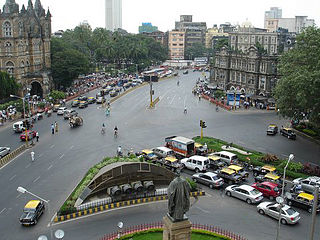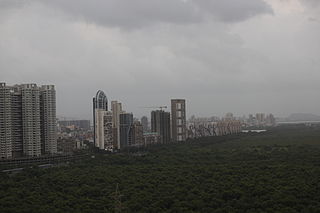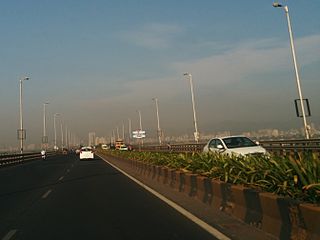
Thane is a metropolitan city located on the northwestern side of the state of Maharashtra in India. It is an immediate neighbour of Mumbai city proper, and a part of the Mumbai Metropolitan Region. It is situated in the north-eastern portion of the Salsette Island.

Transport in Mumbai is achieved by both public, and private transport. As of 2015, 52% of commuters use public transport. Mumbai has the largest organized bus transport network among major Indian cities.

Navi Mumbai is a planned city that is adjacent to Mumbai, located in the Konkan division of Maharashtra state, on the mainland of India. Navi Mumbai is situated across two districts, Thane & Raigad. It is a part of the Mumbai Metropolitan Area.

Airoli is a residential and commercial area of Navi Mumbai in the Indian state of Maharashtra. The name Airoli Node is derived from Airoli-Diva Gaon the largest village prominent in the node node.

Thane Creek is an inlet in the shoreline of the Arabian Sea that isolates the city of Mumbai from the Konkan region of the Indian mainland. It comprises the area between Mumbra Retibunder and the Mankhurd-Vashi Bridge. The creek is divided into two parts. The first part lies between Ghodbunder and Thane (Thana), a section from where the Ulhas river flows from the north of Mumbai Island to meet the Arabian Sea on the west. The second part of the waterway lies between the city of Thane and the Arabian Sea at Trombay / Uran, before the Gharapuri islands.
Juhu Vashi is an upmarket residential and commercial node in Navi Mumbai, Maharashtra, across the Thane Creek of the Arabian Sea on the outskirts of city of Mumbai. The Juhu Vashi is named after the largest village Juhu Village/Vashi Gaon present in Juhu-Vashi Node.
The Harbour line is a branch line of the Mumbai Suburban Railway operated by Central Railway. It was named so because it catered to the eastern neighbourhoods along the city's natural harbour. Its termini are Chhatrapati Shivaji Maharaj Terminus (CSMT), Goregaon and Panvel on the CSMT-Goregaon, CSMT-Panvel and Panvel-Goregaon routes.

The Mumbai–Pune Expressway is India's first 6-lane wide concrete, access-controlled tolled expressway. It spans a distance of 94.5 km connecting Raigad-Navi Mumbai-Mumbai, the capital of Maharashtra state and the financial capital of India, with Pune, the cultural and educational capital of Maharashtra. The expressway, which was fully operationalized in 2002, introduced new levels of speed and safety in automobile transportation to Indian roads. It is one of India's busiest roads.

The Airoli Bridge is a bridge in the Mumbai Metropolitan Region of India. It was constructed to establish a direct road link between Mumbai and Navi Mumbai.

The Maharashtra State Road Development Corporation Limited, commonly abbreviated as MSRDC, is an Indian public limited company fully owned by the Government of Maharashtra. MSRDC was established on July 9, 1996 and incorporated as a public limited company under the Companies Act 1956 on August 2, 1996. It is responsible for developing, building and maintaining roads in Maharashtra.
The Mumbai Trans Harbour Link, officially named as Shri Atal Bihari Vajpayee Trans Harbour Link and also known as Sewri–Nhava Sheva Trans Harbour Link and colloquially as Atal Setu, is a 21.8 km (13.5 mi) 6-lane elevated highway bridge, which connects Mumbai with Navi Mumbai, its satellite city. It is the longest sea bridge in India, and the world's 12th longest sea bridge. The bridge begins in Sewri, South Mumbai, crosses Thane Creek north of Elephanta Island, and terminates at Chirle near Nhava Sheva in Uran taluka, Navi Mumbai. The road is linked to the Mumbai–Pune Expressway in the east and to the under-construction Coastal Road in the west. The 6-lane highway is 27 meters in width, in addition to two emergency exit lanes, two edge strips, parallel crash barriers and noise barriers on both sides. The project costs a total of ₹17,843 crore (US$2.2 billion). The bridge has a capacity to handle 70,000 vehicles per day. Construction on the bridge began in April 2018, and was inaugurated by Prime Minister Narendra Modi on 12 January 2024.
The Sion Panvel Expressway is a 25 km Indian highway located entirely in the state of Maharashtra, that connects Sion in Mumbai with Panvel, via Navi Mumbai. It is one of the busiest and most important roads in the Mumbai Metropolitan Region (MMR) and connects Mumbai with the city of Pune. The National Highway 4 and Mumbai-Pune Expressway begin at the eastern end of the expressway, at Kalamboli junction, near Panvel. The highway is also used by vehicles traveling towards Mumbai from Konkan and Goa.

Airoli is a railway station on the Harbour line of the Mumbai Suburban Railway network located at the Navi Mumbai node of Airoli.
The CST–Panvel fast corridor is a proposed elevated suburban rail corridor on the Harbour Line of the Mumbai Suburban Railway for air-conditioned EMUs.
Shrikant Eknath Shinde is a member of the 17th Lok Sabha of India. He represents the Kalyan constituency of Maharashtra and is a member of the Shiv Sena political party.
Thane–Belapur Road is a major road connecting the city of Thane with Navi Mumbai. The southern end of Thane–Belapur Road starts at the Sion Panvel Highway near Juinagar. The road passes through a busy Thane – Belapur region and generally runs in a north–south direction. During the stretch between Turbhe and Digha, the Thane–Belapur Road runs completely parallel to the Trans-Harbour Line of Mumbai Suburban Railway and the stations of Airoli, Rabale, Ghansoli, Kopar Khairane and Turbhe all have direct access from this road. This road also connects the cities of Thane, Kalwa, and Airoli to the Mumbai-Pune Expressway.

Water transport in Mumbai consists of ferries, hovercraft and catamarans.
The Vikhroli-Kopar Khairane Link Road (VKLR), also known as the JVLR-Kopar Khairane-Ghansoli Bridge, is a proposed 7.5 km to 10 km, freeway grade road bridge connecting the Indian city of Mumbai with Navi Mumbai, its satellite city. The new link road would start at Eastern Express Highway (EEH) where Jogeshwari–Vikhroli Link Road (JVLR) ends in Vikhroli, then cross Thane Creek and Harbour railway line and will terminate at Kopar Khairane in Navi Mumbai before ending on Thane-Belapur Road. The link would be a six-lane road of about 10 km in length including a 2-kilometre-long (1.2 mi) bridge over the Thane Creek. At present motorists have to take either the Vashi Bridge or Mulund-Airoli Link Road to go to Navi Mumbai and Pune. The new road will help motorists save time and fuel. The project is estimated to cost around ₹ 550 to 1200 crore. Mumbai Metropolitan Region Development Authority (MMRDA) appointed N P Bridging, as designing consultants for the project, which was supposed to submit the final report on the link road by mid-September 2016.
Digha Gaon railway station is a railway station located in the Thane district of Maharashtra, India. The station includes two platforms, each 270 meters long and 12 meters wide, designed to accommodate 12-car local trains. It will also have several passenger facilities, including two lifts, six escalators and four underpasses.
Kalwa Bridge is a road bridge across Thane Creek in the Mumbai Metropolitan Region, which connects the city of Thane to the Indian mainland at Kalwa. There are three separate bridges connecting Thane with Kalwa. The first Kalwa Bridge was built in 1863 and was the first bridge crossing Thane Creek. The second Kalwa Bridge was opened in 1995. The third Kalwa Bridge was partially opened to traffic on 13 November 2022, and was completed on 10 March 2023.












